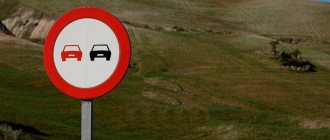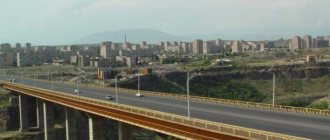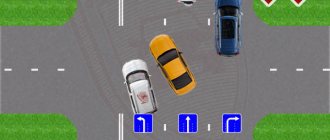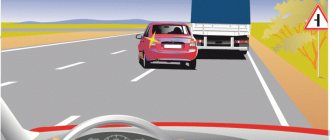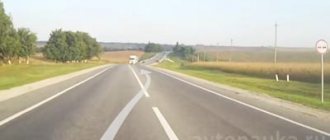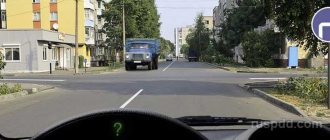Traffic rules clearly regulate any situations that may occur on the territory of the Russian Federation. One of the most dangerous maneuvers for motorists is overtaking a passing vehicle.
Dear readers! The article talks about typical ways to resolve legal issues, but each case is individual. If you want to find out how to solve your particular problem , contact a consultant:
+7 (499) 938-81-90 (Moscow)
+7 (812) 467-32-77 (Saint Petersburg)
8 (800) 301-79-36 (Regions)
APPLICATIONS AND CALLS ARE ACCEPTED 24/7 and 7 days a week.
It's fast and FREE !
Therefore, the rules regulate controversial issues when overtaking and prohibit maneuvering in several cases. In particular, overtaking is prohibited at the end of the climb, as well as at any point where visibility of the road is limited.
How to identify such an area
In a general sense, a rise on a road is a section that has a longitudinal upward direction in the same direction as moving traffic.
There are different types of climbs: small inclines, moderate inclines and steep inclines. Therefore, a system of signs has been developed to indicate the presence of a particular rise ahead of traffic.
Special road signs are used to indicate ascents and descents:
Based on GOST, you can roughly determine the distance that must be in clear visibility to overtake on a hill - about 300 meters. In the absence of such visibility, it is not worth performing a maneuver to avoid problems.
In addition, if the car has little power or moves at high speed, then visibility should be approximately 600 meters. Otherwise, there is a chance of creating an emergency.
Signs indicating areas of the road where overtaking is prohibited
First you need to deal with the issue of lifting on the road. This term refers to a section of road that has a longitudinal increase in the direction of vehicle movement.
There are several types of this area:
- rise with a slight incline;
- medium height rise;
- The steep climb.
It follows that each area has its own specific prohibition sign.
It is worth noting that overtaking on a hill is allowed if you see a special sign at a distance of 300 meters. If you don’t have such visibility, then you shouldn’t overtake. Also, if your car is moving at very high speed, then this distance should be at least 600 meters.
Is overtaking on a hill prohibited?
By law, overtaking on a hill is not completely prohibited. There are times when the ascent lasts several kilometers or even tens of kilometers. In this case, overtaking in the area will be allowed provided there is good visibility of the road.
Another option is the end of the climb. This stretch of road is considered a section with limited visibility. Consequently, the driver cannot fully assess the movement of other vehicles nearby. Therefore, overtaking is prohibited here. Failure to comply with the rule in this case will be prosecuted by law.
In addition, if there are two or more lanes in the direction of travel, then overtaking is not necessary. This maneuver will be called advance. This situation is not described in the traffic rules, so advance on any part of the climb is allowed.
In addition to overtaking, you should not make a U-turn at the end of the climb. Such a maneuver will be counted as driving into another lane, and therefore traffic police officers have the right to bring charges for driving into the oncoming lane.
Overtaking on a hill
When overtaking on sections of road where there is an upward slope, visibility of what is happening ahead is extremely important. Since this is difficult at the end of the climb, in these places the law prohibits making detours of vehicles moving ahead.
Any violations of traffic rules (Road Traffic Rules) are fraught not only with financial penalties from the motorist, but also with other types of punishment.
Drivers need to know when it is legal to overtake on a hill and when it is not.
What can it lead to?
Every competent car enthusiast or professional knows how to correctly identify such a section as a rise.
Ascents are those sections of roads that slope vertically upward, and descents are those that slope downward.
Some elevated places end in straight horizontal roads, while others may have an almost immediate descent.
The slopes are determined by the following types:
- small;
- average;
- cool.
What slope and how steep are shown by road signs, and drivers are already guided by them. This is required to make it easier for motorists to immediately adjust to changing gears.
Overtaking can be done within visibility, which is measured by an approximate distance of more than 300 m.
And for fast-moving cars, this distance, as a rule, doubles and cannot be more than 600 m for overtaking. If such rules are not followed, there is a risk of creating emergency situations.
When the visibility of what is happening on the road is limited due to the height of the slope of the road, overtaking cannot be done because there is no way to see whether an oncoming car is coming, how close it is, whether there is a car nearby that has already crossed the extreme height mark and has begun to descend, after all, he is no longer visible and so on.
If you ignore the rules, you can collide head-on with an oncoming car, which will appear due to the slope exactly at the moment when the driver, while overtaking, enters the oncoming lane.
Responsibility
The measure of liability for overtaking is established in accordance with the Code of Administrative Offenses. The Code does not distinguish between the different situations of overtaking and advancing. Therefore, punishment is standard for various types of offenses.
The Code of Administrative Offenses means that for illegal overtaking, the driver receives one of two punishments: a fine or deprivation of his driver’s license.
The standard fine for illegal overtaking is 5 thousand rubles. However, punishment is provided not only for those motorists who made a maneuver by ignoring traffic signs.
That is, if during any maneuver, including when driving in the oncoming lane, the driver creates an obstacle to the movement of other vehicles, then he will be fined or deprived of his license for up to six months.
Typically, the maximum period of deprivation of rights is 1 calendar year. The same period is provided in case of repeated violation of the same article, that is, committing illegal overtaking again.
However, such punishment is possible only with personal testimony of the incident by a traffic police officer. When filming the incident on camera, the maximum permissible punishment for the driver is a fine.
What does a driver face for violating the rules?
Violation of traffic rules is subject to administrative punishment.
- Overtaking in the area covered by sign 3.20 “Overtaking is prohibited” entails a fine of 5,000 rubles or deprivation of a driver’s license for up to six months. This penalty will be imposed if the sign is accompanied by a solid line marking. If you overtake through a double line, you may be deprived of your license for 1 year.
- Overtaking on the side of the road is punishable by a fine of 1,500 rubles.
- Overtaking on a bridge, in a tunnel, at a pedestrian crossing, etc. will entail a fine of 5,000 rubles or deprivation of a license for six months.
- For overtaking at an intersection - a fine of 5,000 rubles.
- For driving on the sidewalk - a fine of 2,000 rubles.
Traffic police officers can take a position immediately after the rise. This allows them to catch trespassers who overtake at the end of the mountain. It will be almost impossible to justify yourself if caught red-handed. The fine for violating the rules of overtaking can reach 5 thousand rubles. If overtaking is done through a continuous line or under a 3.20 sign, the offender will be deprived of his driver’s license for several months.
IMPORTANT! For overtaking at the end of a rise while crossing a solid line or violating the “overtaking is prohibited” sign, a fine of 5,000 rubles or deprivation of the right to drive vehicles for a period of four to six months is provided. (Part 4 of Article 12.15 of the Administrative Code).
Deprivation of rights cannot be replaced by a fine: the choice of punishment depends on the court. But only one measure can be applied to the violator - a fine or deprivation. Repeated violations result in a more severe penalty. For example, if for the first offense the driver was fined 5 thousand, then for the second offense he will be deprived of his license for 4-12 months (depending on the type of violation).
Is it possible to appeal
If necessary, the decision of the traffic police can be appealed in court. Especially in situations where the driver considers the actions of the police officers to be unlawful or erroneous.
To appeal a penalty for overtaking on a hill, you should act in accordance with the following tips:
- Request a copy of the road project from the DRSU or from the owner of the site. This diagram should indicate all the signs on the road, detailed markings, all turns and slopes in one direction or another. In addition, the owner may know, and can also provide a diagram, on which sections of the road visibility is truly limited. For a detailed analysis of the road layout, a specialist should be invited to the court.
- Attach to the testimony extracts from laws and GOSTs, which indicate that forward visibility should be at least 255 meters.
- Provide evidence of the absence of special signs using photos or videos of the area where the overtaking took place. In the absence of signs, such an area should not be considered an area with limited visibility. Therefore, there should be no complaints from the traffic police officers.
- In the case of not overtaking, but ahead of a passing car, prove the fact of such a maneuver in court. If there was no driving into the oncoming lane, then there is no corpus delicti.
- Submit a witness to the court who will confirm either the absence of signs or refute the fact of overtaking. Also, if there is a witness, it should be indicated that the inspector deliberately did not take him into account when drawing up the protocol.
- Use the services of a lawyer. It is almost impossible to independently find flaws in the process or violation of your own rights. It is much easier for a specialist to understand all the nuances.
In addition, the court usually takes into account various mitigating circumstances when making the final decision. Such circumstances may be the repentance of the guilty person, the prevention of another offense through maneuver. The court also takes into account the pregnancy or maternity of the female driver.
So, overtaking on the territory at the end of the climb is one of the prohibited maneuvers. Failure to comply with the law can cause accidents and other emergency situations. In addition, for such drivers the amount of a fine is established at the legislative level, and in case of particularly dangerous offenses - deprivation of a driver's license.
Appeal against punishment
If you believe that the actions of the traffic police inspector are unlawful or erroneous, you have every right to appeal the received punishment in court.
The procedure to take for this is:
- Obtain a copy of the road section project from the DRSU or from its owner. This act will help you find out the exact location of all road signs and markings. A specialist will help you deal with such a copy.
- Attach to your testimony quotations from GOST, which indicate the permissible visibility.
- Prove the fact that there are no special signs, that is, a video or photo of the area where the overtaking took place.
- If the driver was overtaking, he must prove that he did not enter the oncoming lane.
- Find a witness who confirms the absence of signs, or the fact of advancing and not overtaking. An important condition will be to indicate to the court that the traffic police inspector did not consider it necessary to include this information in the protocol.
- We advise you to seek help from a lawyer who specializes in this type of case, because it will be much easier for him to find a way to refute the punishment.
Moreover, I would like to note that in these court cases various mitigating circumstances are often taken into account. For example, driver’s remorse, performing a maneuver to prevent an accident, etc. The court also takes into account the fact that the driver was a woman who was pregnant or the mother of a minor child.
When performing this maneuver in a prohibited area, you must be clearly aware that you may not only lose your license or pay a fine, but also provoke a serious accident that will result in injury or death.
Be vigilant on the roads and follow traffic rules so as not to become the culprit of an accident.
Attention! Within our portal, you can get advice from an experienced lawyer completely free of charge. All you need to do is leave your question in the form below. Contact us!
